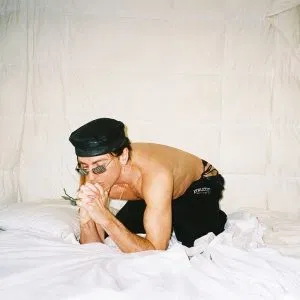Have you ever seen an amphitheatre filled with smiling goths?
I have–last Saturday night when the Count himself, Peter Murphy, and former Bauhaus bassist David J, brought 40 years of Bauhaus to MTELUS in Montreal.
Whether they looked like they stepped out of a time machine from the ‘80s, shop at Killstar, or are goths - but only at heart, the theatre was packed with those rife with nostalgia waiting to watch the godfathers of Goth (gothfathers) prove that the genre didn’t die; it’s undead (undead undead).
The Bauhaus duo was joined with guitarist Mark Thwaite, who has worked with Murphy on his solo stuff, and Splender’s former drummer, Marc Slutsky. But ultimately, the show was all about the Bauhaus reunion.
After the lanky frontman slunked on stage, the show kicked off with Murphy groaning, shouting, and singing his way through the first nine tracks of In The Flat Field (minus Dark Entries, to my huge disappointment).
In the opening “Double Dare,” Murphy menacingly swung around his microphone stand while taunting the crowd with “I dare you, I dare you.”
The microphone stand is clearly his favourite of the many props he brought out, as he also used it to recreate imagery of Christ’s crucifixion during “Stigmata Martyr,” as he cried and moaned while the abrasive drums and buzzsaw guitar bolstered the track’s eerie atmosphere.
Murphy’s clear eyes seemed to pierce through each of our souls, gleaming in the lights and penetrating the smoke as he contorted himself and oscillated, like he was possessed by an elegant demon.
Among other props he had was a golden crown, which he held up, twirled, and stared at in fascination as he crooned through “God in an Alcove” before throwing it back stage. He also pulled out a bullhorn to recreate his vocals on “Small Talk Stinks,” and a melodica for my personal favourite Bauhaus song “She’s in Parties.”
With his multiple costume changes–going from a glittery black jacket to a shirt with a large collar and multiple chains around his neck–and his elegant looming figure, Murphy embodied his music, which ranges from gloomy to glam rock.
Murphy, whose temper and outbursts are legendary, couldn’t help himself from taking small jabs at the crowd. After reminiscing about the six months he once spent living in Montreal, he joked around about us “French-Canadian twits” and our culture. This led to some leaving the building.
The whole room held its breath for the nine-minute rendition of “Bela Lugosi’s Dead.” With his shirt’s collar popped up like Dracula’s, Murphy mumbled about the Hungarian Count as the vampires around me sang along and swayed like trees in the wind.
The crowd couldn’t get enough Bauhaus, and they came out for two encores, closing off the night with “Ziggy Stardust” as the crowd erupted.
But, this reunion was about far more than just reminiscing about ‘80s rock music, it was about celebrating 40 years of Goth rock and the birth of the subculture. In 1979, Bauhaus released “Bela Lugosi’s Dead” and officially birthed the genre.
Though punk and post-punk bands like The Damned, Siouxsie and the Banshees, and Joy Division had done some groundwork, Bauhaus was the last nail in the coffin.
The genre, featuring mysterious and theatrical artists, fascinated by romanticism, morose, and taboo things, was heavily influenced by post-punk and glam rock, with prominent bass lines, tribal drums, and eerie guitars with lots of reverb.
Bands like The Cure, Christian Death, Fields of the Nephilim, and Sisters of Mercy were born in the 1980s, forming the first wave of Goth.
With the gloomy, romantic, and dark music grew a subculture–spooky kids with pale skin, too much eye makeup, pixie boots, black clothes, fishnets, and dyed black hair crimped and teased, started to emerge from their batcaves.
The music reflected the economic and social gloom of the 1980s in the United Kingdom, with Margaret Thatcher’s “haves and have nots” policies and the free-market fundamentalism.
There was social unrest and distrust of the police. The “SUS” law lead to accusations of police racial profiling, there were riots in Brixton, Toxteth and in other cities. The 1978 Ridley Plan was implemented and put an end to the coal miners’ strikes in 1984–1985. People were stopped at random, and at times, it felt like a police state for some.
Eastern Europe was communist and seen as dreary, the Soviet Union was the “outside enemy,” and the effects of the cold war were felt in the United Kingdom. Unrest could be felt from within the United Kingdom as well with the Irish Republican Army fighting for seperation. It seemed like everyone was ready for a social, political, and economic revolution.
As the genre kept growing, and a second generation of bands came along–those who defined themselves as Goth, such as Rosetta Stone, London After Midnight and The Shroud, all coming in through the ‘80s and ‘90s. The genre grew larger and spread to the Americas.
Here’s where it gets a bit contentious: Goth is now in its third wave and has come a long way from where it was where Murphy first wrote a nine minute long masterpiece about the Hungarian actor who played Dracula. Traditional goths are few and far between. There are still “goth girlfriend” memes circulating the Internet.
From cyber goths, pastel goths, industrial goths, and trap goths, the fashion has leaked into the mainstream (with dark aesthetics becoming high-fashion) and trickled down into the cracks of genres like rap and electronic music.
I mean, walk through the Mile-End and everyone is wearing black clothes, fishnets, and smoking $8 cigarettes.
No matter how much Goth has grown, distorted, and reconstructed itself, Murphy and company brought it back to its roots and reminded everyone who the real gothfather is.
Photo credits: writer’s own
Cover photo: post-punk.com







